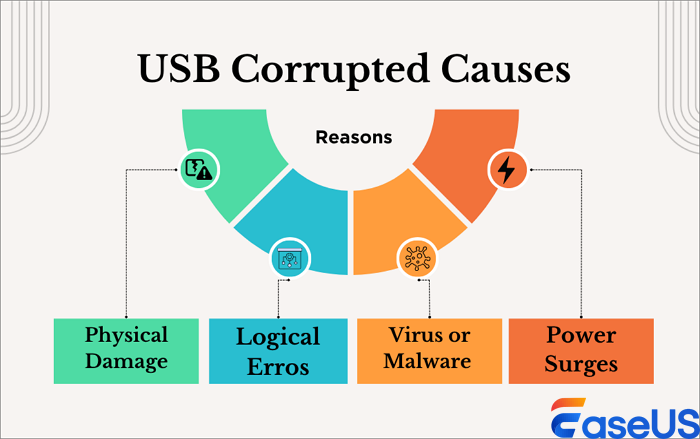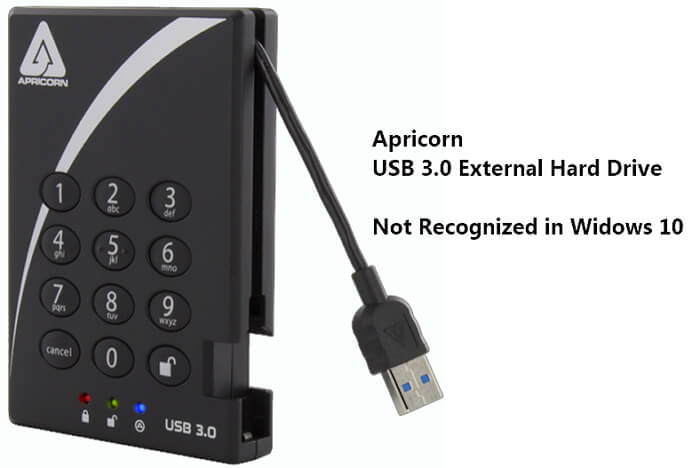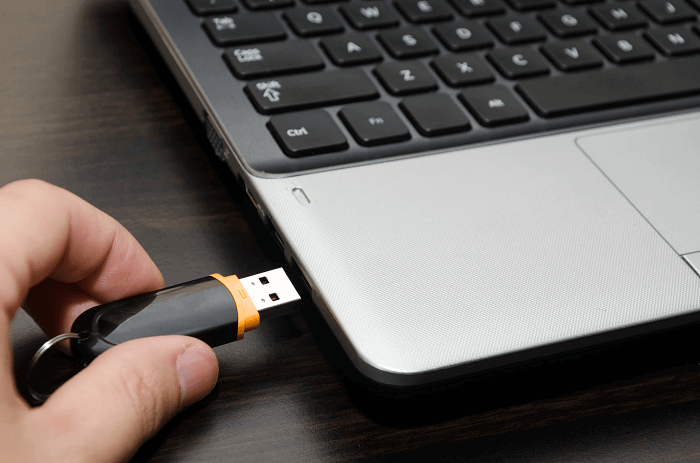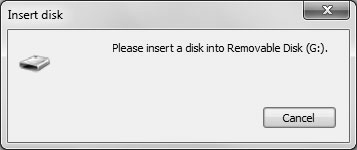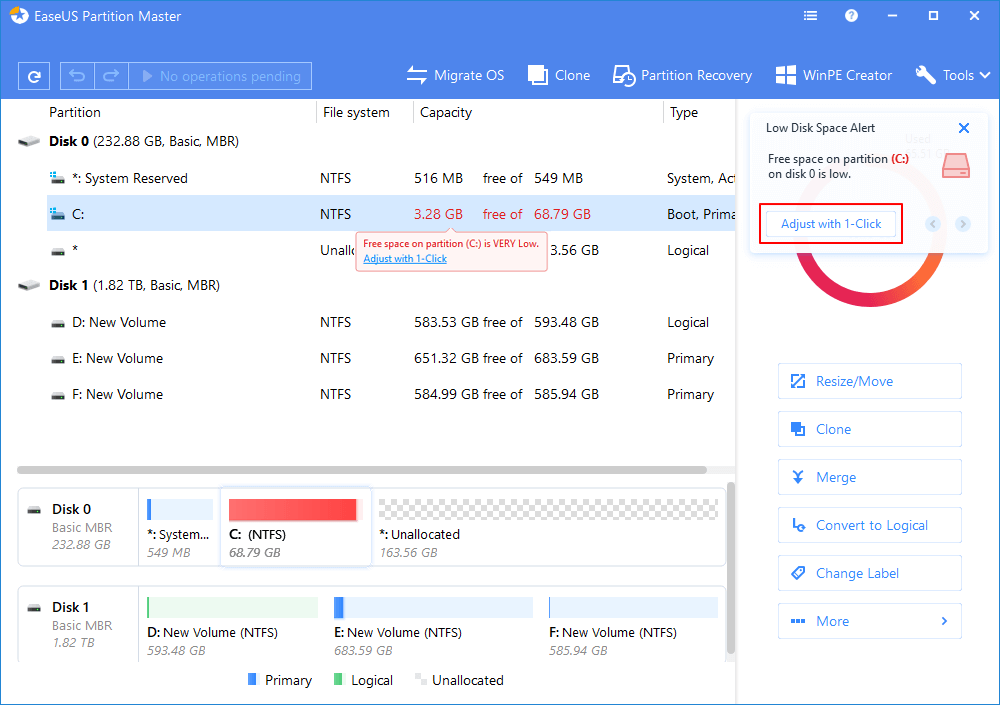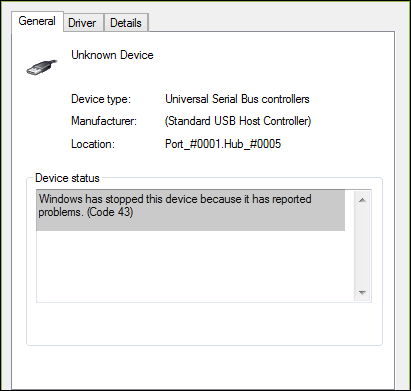-
![]()
-
![]()
-
![]() Free | How to Recover Files from Formatted USB/Pen Drive
Free | How to Recover Files from Formatted USB/Pen Drive December 12,2025
December 12,2025 6 min read
6 min read -
![]() How to Fix Corrupted USB Without Formatting | 6 Solutions
How to Fix Corrupted USB Without Formatting | 6 Solutions December 15,2025
December 15,2025 6 min read
6 min read -
![]() Fix 'Please Insert a Disk into USB Drive' Without Losing Data
Fix 'Please Insert a Disk into USB Drive' Without Losing Data December 12,2025
December 12,2025 6 min read
6 min read -
![]()
-
![]() How to Format a Flash Drive Without Losing Data (Complete Guide)
How to Format a Flash Drive Without Losing Data (Complete Guide) December 12,2025
December 12,2025 6 min read
6 min read -
![]() Free Download the USB Data Recovery Software Full Version | 2025 Best Choice
Free Download the USB Data Recovery Software Full Version | 2025 Best Choice December 12,2025
December 12,2025 6 min read
6 min read -
![]() Fix Error Code 43 USB Error | Recover Data from USB Drive
Fix Error Code 43 USB Error | Recover Data from USB Drive December 12,2025
December 12,2025 6 min read
6 min read -
![]() How to Recover Data from USB Flash Drive [for All Scenarios]
How to Recover Data from USB Flash Drive [for All Scenarios] December 18,2025
December 18,2025 6 min read
6 min read
Page Table of Contents
To repair a corrupted USB drive, try the CHKDSK command ro scan for the drive error and fix it. If it fails, try using a data recovery tool to restore your files try using a data recovery tool to restore your files and formatting your USB as a last resort.
PAGE CONTENT:
A portable storage device is a USB flash drive, pen drive, or external hard drive. This device allows people to carry their data anywhere they go and use it with various devices. Sometimes, this frequent use of the USB device can cause issues, like leading the USB drive to become corrupted.
The USB damage can be simply divided into logical and physical corruption. If the device still recognizes your USB, then the following methods can help you repair USB drive and restore lost files. Otherwise, you might need to look for local service if your USB is not detected.
How USB Flash Drive Gets Corrupted
USB drives can get corrupted for several reasons; if you find your USB damaged, your USB is highly likely to have been through situations like physical wear and tear, improper removal, or internal issues like damaged sectors or malware attacks. But the causes fall into two main categories, as shown in the infographic:
USB Drive Corruption Symptoms and Repair Methods
There are many different symptoms of a corrupted USB. You may receive an error message saying you need to format the drive before you use it, or your USB may disconnect every 30 seconds and then freeze up, as in a real case posted in the Microsoft Community. To better suit the methods to the situation, here is a table that directs you to the recommended ways based on your symptoms.
| Symptom | Description | Method |
| 🌩️Missing/Invisible Files or Corruption | Your USB can be recognized by the device, but the files disappear, or some folders show as empty. |
Check and Fix the Error on the Damaged USB with Built-in Utility |
| ❌File System Errors | One of the most common symptoms of logical corruption. | Run CHKDSK to Fix USB Corrupted File System Error |
| 💾Partition Table Corruption | Your partition table becomes unreadable or displays incorrect information when you try accessing its data. | How to Fix USB Flash Drive by Reinstalling USB Driver |
| ⌨️Frequent Input/Output Errors | When attempting to read or write data, you may encounter a system error reporting an input or output error. | Repair USB Stick Issues by Formatting It |
| 🗂️File Cannot Be Opened or Corrupted | When accessing the files on your USB, you may receive the error message indicating the files are corrupted or unreadable. | Repair USB Flash Drive with Windows Security |
| 🔒Permission System Failure | You may find your files suddenly becoming read-only, or your security tab shows unknown account ownership. | Repair USB Errors with a Manual Repair Service |
How do you repair a USB drive without losing data? It is important to rescue data from your corrupted USB flash drive with data recovery software first.
🏅First Aid: Recover Data from Corrupted USB Drive
| 💡Note |
If you have already spotted that your USB is corrupted, the first thing you should do is to stop using it to avoid writing any new data to the USB device, and consider using a data recovery tool or seeking professional help to try to repair the file system or recover essential data. |
How to repair a corrupted pen drive without losing data and how to restore usb flash drive? When you encounter issues like having a USB drive showing up or a USB drive becoming RAW and not accessible, you'd better try to recover data from the damaged USB flash drive. When you don't have any backups and pen drive data not showing, you should try EaseUS Data Recovery Wizard. You can download this USB data recovery software now.
This software can help you repair a USB drive on Windows without losing data, and you can check the highlights here:
- Recover files from USB, including photos, videos, documents, emails, and audio.
- Support RAW drive recovery; you can recover lost files from a RAW drive with EaseUS recovery software.
- Recover the formatted USB drive with ease. You can format the USB drive and fix the corruption, then perform USB data recovery.
| ⭐Reviews |
|
You can follow these simple steps to recover lost data from the corrupted USB flash drive:
Step 1. Connect your USB stick and scan it with EaseUS Data Recovery Wizard. After launching the software, you can easily locate your USB drive. Tap on Scan for lost data to find your files.
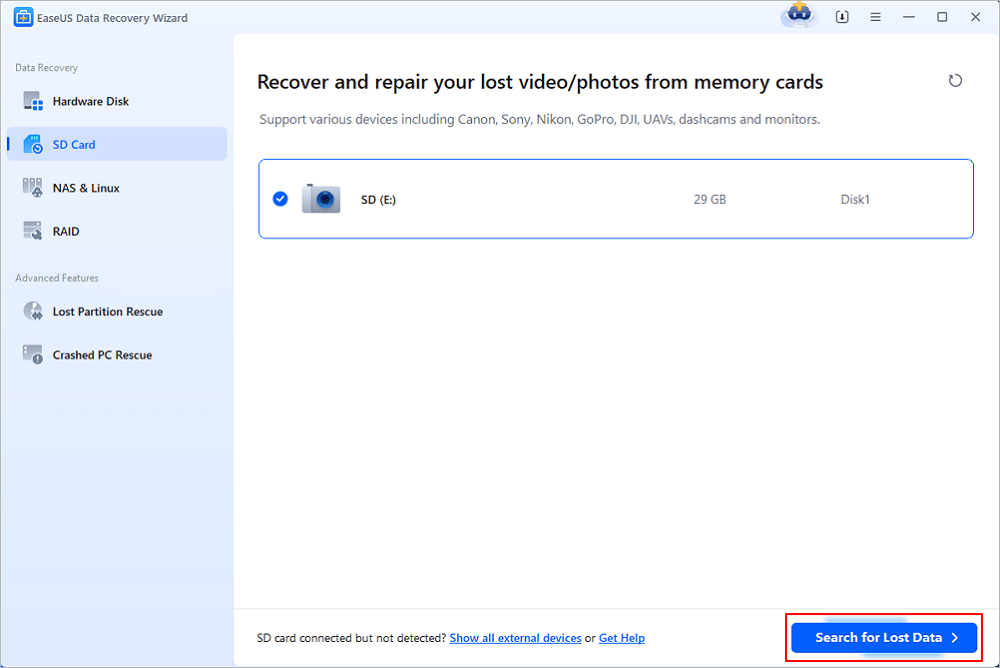
Step 2. You can easily filter the files from the sidebar. Choosing "Path" or "Type" can help you quickly find lost files from USB sticks.
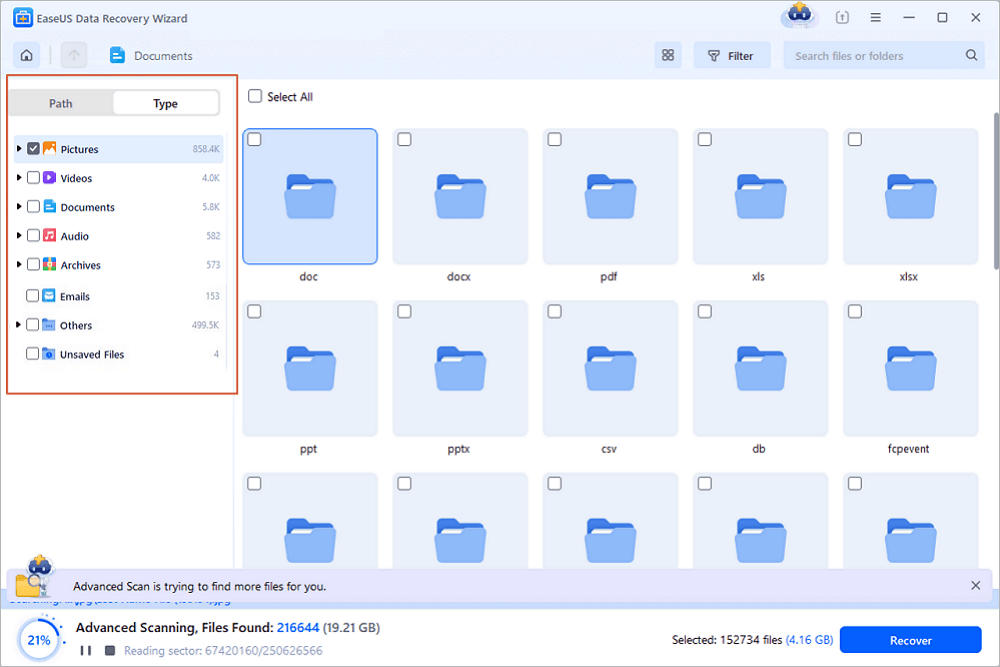
Step 3. You can preview the files before saving them. Click "Recover" and save these recovered files in a new location. Do not save the files on your corrupted USB drive.
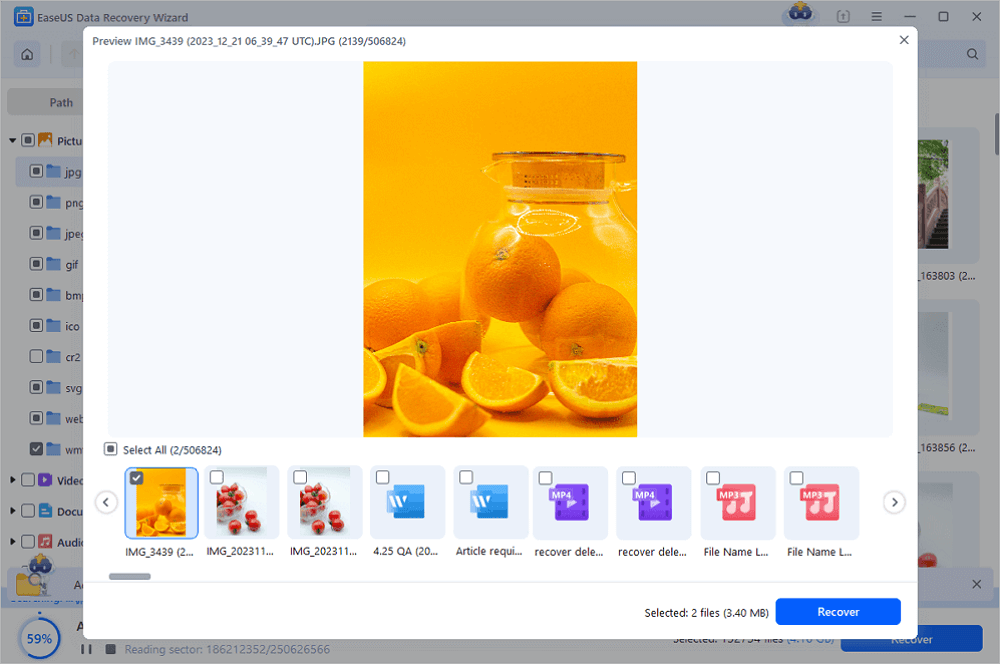
Here's a video tutorial that can help you learn how to repair USB drives and recover data from USB drives.
- 00:48 Method 1. Repair USB with Error Check Tool
- 01:15 Method 2. Fix Corrupted USB with CMD
- 02:09 Method 3. Uninstall USB Driver to Fix USB Drive
- 02:40 Recover USB with EaseUS Data Recovery Wizard

If you have successfully recovered data from your corrupted USB drive, try to share this page on social media to help more readers!
Fix 1. Check and Repair USB Drive with Windows Drive Repair Utility
| 📝Editor's Reviews | Windows operating system has a built-in utility that can check disk errors automatically. |
How to fix a corrupted flash drive? If your flash drive is not physically broken, your computer should recognize it and assign it a drive letter. In this case, follow the methods below to check and fix the logical errors on your USB. These methods shouldn't cause any data loss.
Step 1. Connect the USB to your PC
Step 2. Go to "My Computer/This PC" and then find the USB Drives.
Step 3. Right-click the USB drive and select "Properties".
Step 4. Click on the Tools tab.
Step 5. Click the "Check" button to repair the USB stick.
Step 6. Let the scan process complete, then close the scan window.
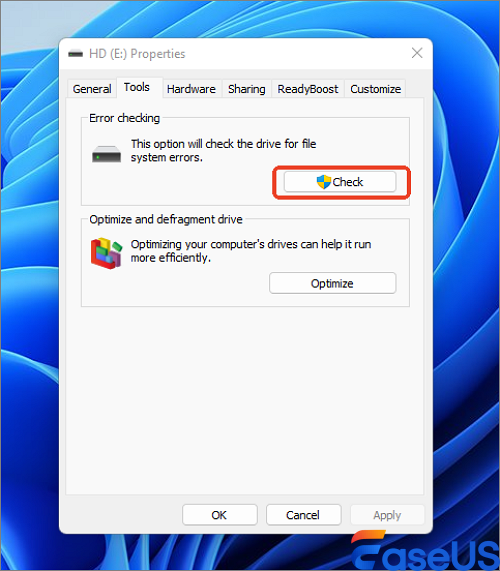
Fix 2. Run CHKDSK to Repair USB Drive Corrupted File System Error
| 📝Editor's Reviews | The CHKDSK command can help you quickly repair the file system errors on your USB stick. |
How to fix a USB? If the USB drive is detected but not accessible on your computer, you can try to fix the logical error using the native Windows tool, Command Prompt, or a third-party fixing tool. Then, you will be able to access your USB.
This is essentially the same process as above, but this will provide you with more feedback in the end that will help you determine whether the problem has been fixed or not.
- Warning
- Running chkdsk can hopefully repair file system errors. However, it can also result in total data loss. So, perform data recovery with EaseUS Data Recovery Wizard in advance and then continue with the CMD method.
Step 1. Plug in your USB flash drive or pen drive to your computer.
Step 2. Type cmd in the search box. You'll see "Command Prompt" in the search results.
Step 3. Select "Run as administrator". Then, type chkdsk /X /f H: (replacing H with your USB's drive letter) in the Command Prompt window and hit Enter. The chkdsk operation will start to repair damaged USB drives.
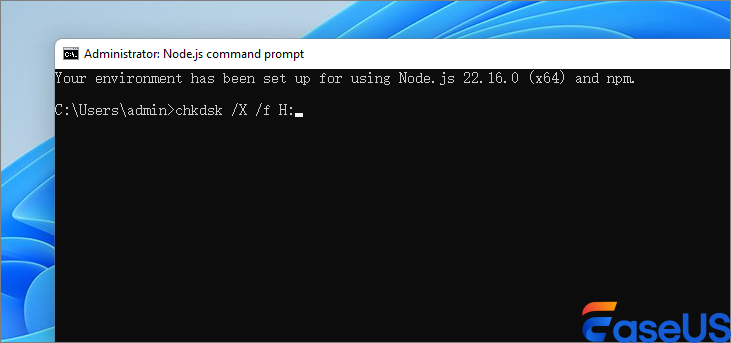
This command makes the Windows operating system scan and repair file system errors on the flash drive. If the repair process works properly, it will show Windows has made corrections to the file system in the command window. This suggests that the corrupted USB pen drive has been successfully fixed and can be accessed again.
Fix 3. How to Repair USB Flash Drive by Reinstalling USB Driver
| 📝Editor's Reviews | An easy-to-try but often neglected method worth trying, you can update first, if it fails, try reinstalling it. |
How can i repair my usb flash drive? If your USB drive is physically damaged and cannot be detected or recognized, reinstalling the USB drivers is worth trying. Or, you can try to connect your device to different USB ports to diagnose the problem.
Many strange USB issues usually result from a corrupted driver. You need to reinstall a new driver by following the steps.
Step 1. Press the Windows + X keys and select "Device Manager" from the menu.
Step 2. Expand Disk drives, right-click the name of your removable USB disk, and select "Uninstall".
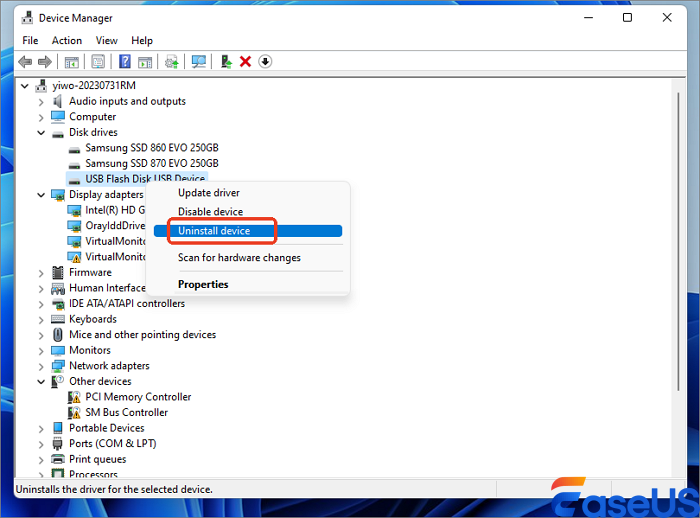
Step 3. Select "OK" and disconnect the USB drive from your computer.
Step 4. Restart your computer and connect your USB drive to your computer. Windows will automatically install the required drivers for you.
You can also try to update the USB driver to repair corrupted USB, and the following article may help you learn more:

[Tried & True] How to Download and Update USB Drivers
A range of peripherals is connected to your PC via a USB connection. If the USB driver goes wrong, these devices cannot work well. Read more >>
Fix 4. Repair USB Stick Issues by Formatting It
| 📝Editor's Reviews | When your USB drive becomes RAW, you need to format it to another file system before using it. |
Your computer may not recognize the file system of USB drives, or the file system is RAW, and ask you to format it. Basically, you can easily fix this RAW drive problem by formatting the USB, but you should also know that the data on the USB drive will be erased after formatting.
How to format USB drives to fix issues:
Step 1. Insert the USB drive and open the File Explorer.
Step 2. Go to "This PC" and find your USB drive.
Step 3. Right-click the USB and choose "Format". Choose the file system and click "Start".
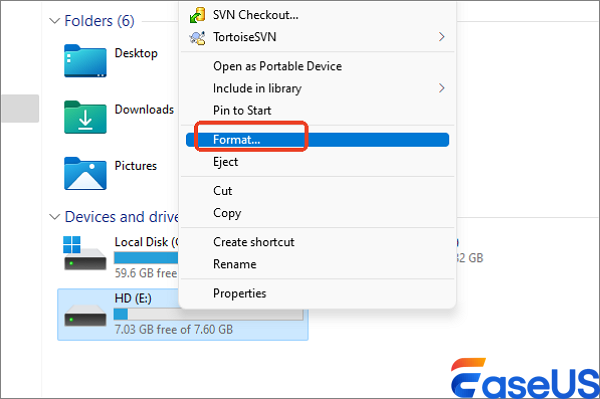
Note: After formatting, you can simply unformat the USB drive with EaseUS Data Recovery Wizard.
Fix 5. Repair USB Flash Drive with Windows Security
| 📝Editor's Reviews | A method that suits well when your USB is infected with malware or a virus. |
If your USB is infected with malware and then becomes unreadable or corrupted, you can try scanning and repairing it with the help of Windows Security.
Step 1. Type Windows Security in the search bar and open it.
Step 2. Navigate to the Virus & threat protection.
Step 3. Click the Scan options in blue and then choose "Custom scan".
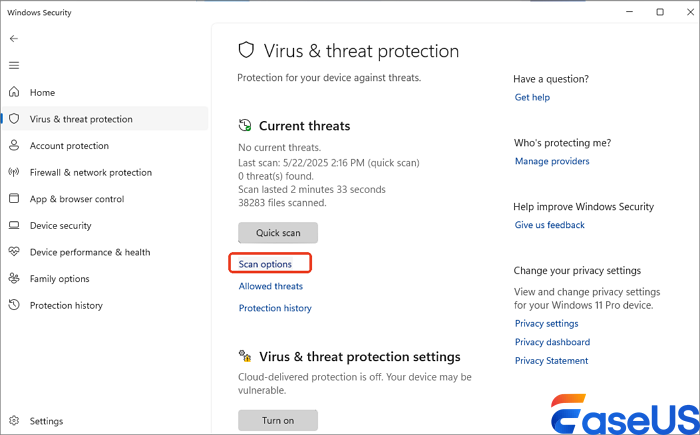
Step 4. Tap on Scan now and choose your USB.
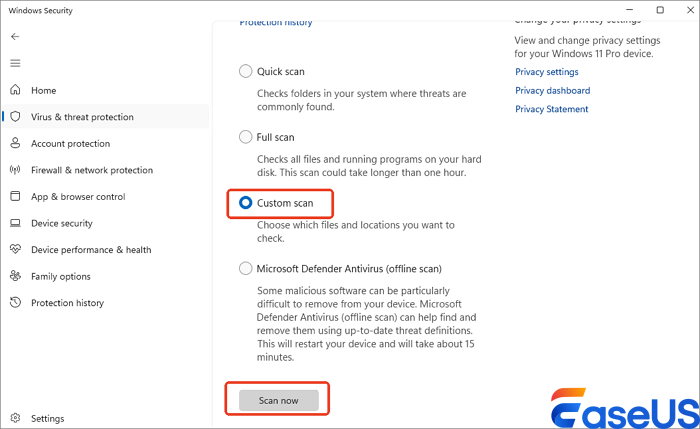
Wait for the process to end, and you can then try opening your drive to see if this method helps.
Fix 6. Repair USB Drive Errors with a Manual Repair Service
| 📝Editor's Reviews | Professional data recovery and disk repair experts will help you resolve the corrupted USB flash drive. |
If you think it is impossible to repair the USB drive or other storage devices by yourself, you can also turn to reliable and powerful data recovery services that easily help you repair corrupted SanDisk, Kingston, Sony, Seagate, or Western Digital USB flash drives. Our professional teams will stay online all day and help you repair the device even if the USB is dead.
Consult with EaseUS recovery experts for one-on-one manual recovery service. We could offer the following services after a FREE diagnosis.
- Repair external hard drive and USB flash drive errors, and restore data from all RAID levels
- Recover a lost partition that cannot be restored by data recovery software
- USB RAW format fix, or the USB that cannot be read or accessed because of bad sectors
- Fix disks that become GPT-protected partitions
- Wipe data, unformat hard drive, install/uninstall software or driver, etc.
Tips to Prevent USB or Pen Drive Corruption
Though it is possible to repair a corrupted USB drive and extract data from the problematic external devices, it is suggested to take preventive measures to prevent USB corruption. Here are some tips you may need to prolong the lifespan of your USB:
- 🖨️Scan for Errors: Periodically run the disk check or scan for errors on your USB drive to identify and fix any issues, and check the health of your USB.
- 🔌Proper Ejection: Remember to safely remove the hardware or use the "Eject" function every time you disconnect the USB to make sure the file system is properly closed.
- 🚿Keep Clean and Dry: Ensure your USB drive and the USB ports on your computer are free of dust and debris. Regularly clean the USB ports with compressed air or a soft brush and keep them away from water.
- 💾Reliable Drives: When buying USB drives, choose the high-quality and reputable brands for saving your critical files.
Final Words
This post from EaseUS has looked at how to fix corrupted flash drive and restore lost data before you repair USB drive. So do not lose heart once you find your files are gone; there are ways out. And remember to make a regular backup and check to protect your important files and USB.
Repair USB Drive FAQs
To get additional help, read these questions and answers below.
1. What to do when a USB drive does not show up?
When a USB is not showing up, you need to:
- Fix 1. Seek Repair Services
- Fix 2. Update USB Driver
- Fix 3. Reinstall Disk Driver
2. How do I tell if my USB is corrupted?
Your USB flash drive is corrupted when it looks empty, appears as RAW, or the pen drive is not detected.
3. Can a USB flash drive be repaired?
Yes. Here are the solutions to fix USB errors:
- Determine the cause of the USB problems
- Repair the USB drive with a repair service
- Repair the USB drive with a USB repair tool
4. Is there a SanDisk repair tool?
Yes, there's a SanDisk repair tool. You can download it from EaseUS with simple clicks. If you find this post helpful, share it on your Twitter and Facebook to help more people.
Was this page helpful?
-
Finley is interested in reading and writing articles about technical knowledge. Her articles mainly focus on file repair and data recovery.…
-
Mahesh is an experienced computer tech writer. He's been writing tech how-to guides for about 8 years now and has covered many topics. He loves to teach people how they can get the most out of their devices.…

20+
Years of experience

160+
Countries and regions

72 Million+
Downloads

4.9 +
Trustpilot Score


Free Data
Recovery Software
Recover data up to 2GB for free!
